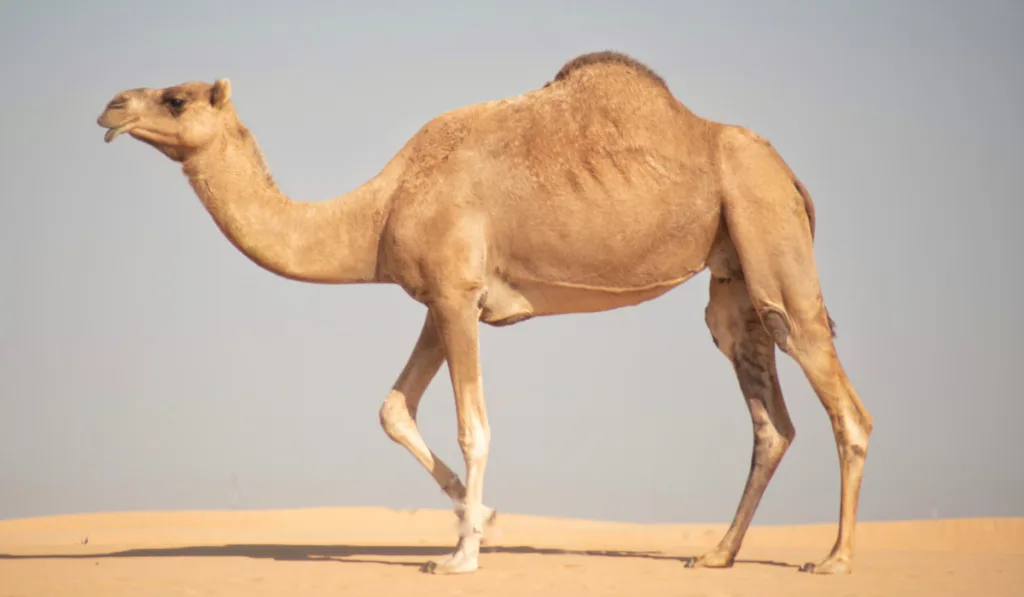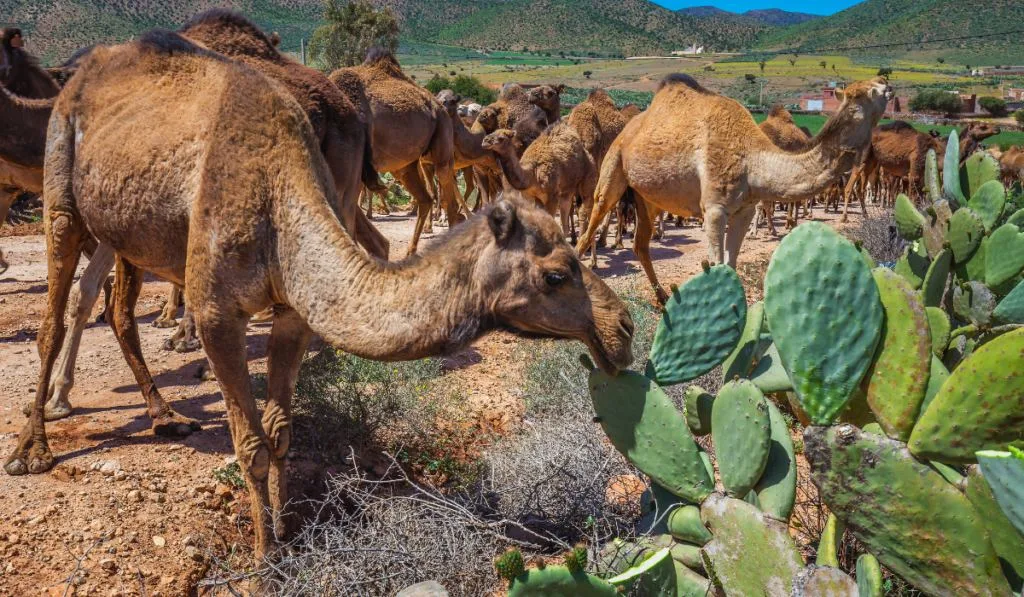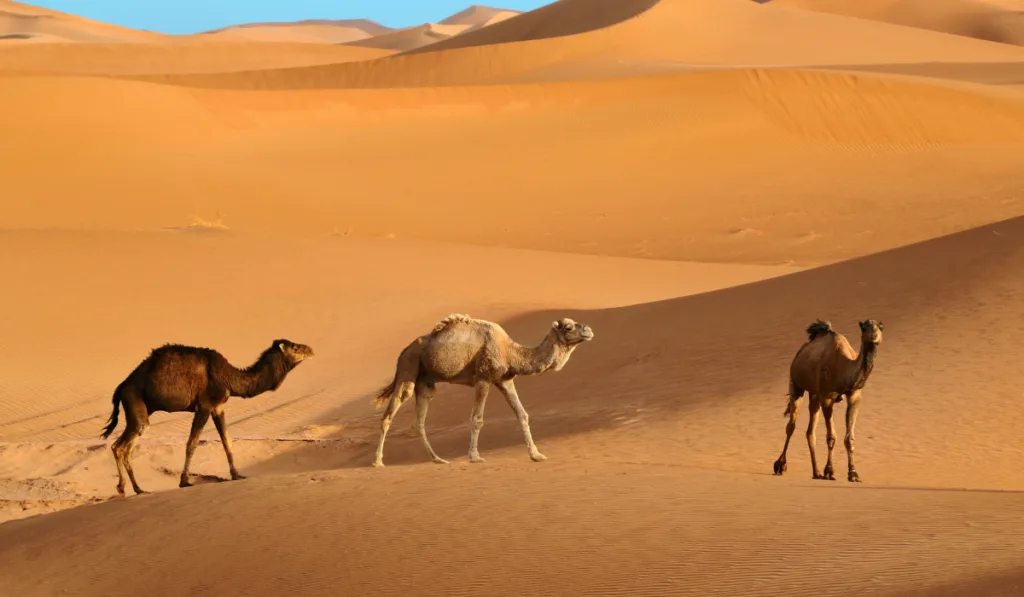Camels are unique animals that are fully equipped for living in the desert. One thing most desert animals suffer from is a scarcity of food and when they do find something, it might not be the most appealing.
An example of a plant that camels may be forced to eat is cactus. Do camels really eat cactus?
How do camels eat cactus without getting hurt by the spines of a cactus?
Can camels eat cactus?
Yes, camels not only eat cactus, they have adapted to eating cactus leaves, spines and all. Camels also gain a lot of nutrition by eating cactus.

What are some of the adaptations camels have that make them able eat cactus comfortably? Do the cactus spines hurt them? Continue reading.
Table of Contents
Camels Eating Cactus
Even though you will think twice about eating cacti with spines as long as 6 inches, camels will happily dive in. As desert-dwelling animals, camels have to make do with whatever they can find.
The truth is that cacti spines can hurt camels, but they have some adaptations to reduce how much harm they receive by eating spiny cactus.
Let us discuss some of the reasons why camels eat a plant like cactus.
Why Camels Eat Cactus

Why would camels eat something that can hurt them? Here are some reasons:
1. They Are Desert Animals
Unlike animals living in the jungle that can find food easily, desert animals often trek for miles without finding food to eat nor water to drink. This means that desert animals have to make do with whatever food they can find, even if it is not appealing to them.
2. They Are Herbivorous Animals
Camels are herbivores. This means that they eat plants and plant products. As you already know, cacti are desert plants, so cacti are technically in the food menu of camels.
3. They Are Ruminants
What are ruminant animals? Ruminant animals are animals that chew their cud after regurgitation. Ruminant animals also have a stomach with compartments. The major feature of ruminant animals is the possession of a rumen.
The rumen in ruminant animals is a compartment of their stomach that houses a diversity of anaerobic bacteria and other microbes. These microbes help camels and other ruminant animals to digest the food that non-ruminant animals cannot digest.
An example of a food that camels can digest but you cannot digest is cellulose (dietary fiber). Cellulose is the woody part of plants.
As you already know, cacti are mostly made of woody parts that are not chewable nor digestible by most animals. Camels and other ruminant animals, however, can digest cellulose and get energy from it.
This means that camels can eat, digest, and get nutrition from every part of a cactus.
4. Cacti Are Nutritious

The table below shows the nutrition value of 100 grams of nopales (prickly pear) cacti:
| Nutrient | Nutrient Value/100 grams |
| Energy | 16 kcal |
| Protein | 1.32 g |
| Total fat | 0.09 g |
| Minerals | 234 mg |
| Vitamins | > 10 mg |
| Dietary Fiber | 2.2 g |
| Carbohydrates | 3.33 g |
(Source)
Even though different cacti have their specific nutrient composition, the nutritional value of nopales cacti can give you a hint of how other cacti nutrient composition will be.
5. Camels Are Well-Equipped to Eat Cactus
Camels have some special adaptations in their mouth that help them to easily eat cacti.
Let us dig deeper into these adaptations.
How Do Camels Eat Cactus?
Here are some features that help camels to eat cactus:
1. Prehensile Upper Lips
The upper lip of a camel is divided into two parts that the camel can move just like fingers. These parts are not just movable, they are also very sensitive and can feel the hardness of items entering into the camel’s mouth.
With the prehensile upper lips, camels can detect the direction of the spines of a cactus and can move their mouth accordingly.
2. Papillae
What are papillae? Papillae are long, cone-shaped protrusions that line the mouth of camels. These papillae prevent most (but not all) spines of cacti from piercing the mouthparts as they push the cactus to the middle of the mouth.
The papillae also direct the food of camels to the stomach in the least harmful manner. In other words, the papillae orient the spines of the cactus to face backward as they are swept down the camel’s throat.
3. Camels Have a Hard Mouth Palate
A palate is the lining between the upper part of a camel’s mouth and nose. The upper part of a camel’s mouth is very hard, so most spines of a cactus will not hurt it.
The teeth and palate in the mouth of camels work just like a mortar and pestle. The teeth of camels grind the cactus and spines against the hard palate of the mouth.
Which of the mentioned camel adaptations is your favorite?

What Else Do Camels Eat?
Asides from cactus, what else do camels eat? Here are some examples of typical camel fodder:
- Oats
- Grass
- Seeds
- Wheat
- Dried leaves
- Thorny twigs
Now that you know that camels do not just feed on just cactus, what are some other animals that can eat cactus? Here are some examples:
Other Animals That Eat Cactus
Here are some animals that feed on cactus and their favorite parts of cactus:
- Jackrabbits: These mammals feed on the base of the cactus where there are no thorns.
- Packrats: They can eat every part of the cactus, but avoid getting stung by the spine of cacti.
- Javelinas: They are unique because just like camels, they can eat every part of the cactus including the spines. Their kidneys are able to filter out a common plant acid, oxalic acid. Oxalic acid is usually found in the cactus spines.
- Ground squirrels: These squirrels that live in underground burrows eat the fruit and seeds of cacti.
- Gophers: Just like ground squirrels, gophers live underground. They eat cactus to get moisture.
- Turtles: With their strong jaws, they feed on the base of cacti avoiding the spines.
Final Thoughts
Camels do not just manage to eat cacti, they are fully-adapted to eating cacti without getting oral injuries from the spines of their meals. Camels, just like other ruminants, can digest the dietary fiber found in cactus, so camels actually get a lot of nutrition from digesting the prickly desert vegetation.
